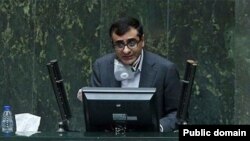In what appears to be candid remarks, Mohammad Qasemi, the head of the Iranian Parliament's Research Center, has painted a bleak picture of Iran economy. He told parliament that structural flaws and weak management have plagued the Iranian economy during the past 40 years.
Qasemi also warned that the potential for economic growth in Iran has been declining since 2011 but did not pin all the blame on sanctions.
He added that Iran should accept sanctions as long-term phenomena because there is no prospect they will disappear soon. On the other hand, Iran does not seem to have a plan for confronting sanctions. "Iran should reconsider how to manage its response to sanctions," Qasemi said.
This remark by Qasemi’s is contrasted with the economic edicts of Supreme Leader Ali Khamenei who has been insisting on the vaguely defined idea of a “Resistance Economy”. The idea emphasizes domestic investment and self-reliance; a concept squarely opposed to globalization, trade and foreign investments.
Qasemi who was speaking at the Iranian Parliament (Majles) on Sunday May 31 said that the potential for creating wealth in Iran has been declining during the past years due to structural flaws and weakness in management and various administrations have been furthering the country's economic affairs with a lot of dependency on oil.
Pointing out the vast difference between planned targets and what has been actually achieved, he said the country's economic plans call for an 8 percent annual economic growth and this will be materialized only if there is enough investment in the country.
According to prominent Iranian economist Fereidoun Khavand, Iran's economic growth rate is a "veritable mystery" as the Central bank often does not announce the rate. According to Khavand, the country's economic growth rate has been hovering around 2 percent in 40 years and was extremely low even before 2011 when international sanctions related to Iran’s nuclear program were imposed. It was 0.50 percent in 2008 and 1.5 percent in 2009, he says.
Qasemi told the newly convened parliament that the potential for economic growth in Iran usually materialized through capital creation in the machinery and construction sectors, however, it has been declining since 2011 and the forecasts indicate that it will further decline in the future.
Iran will need a lot of time before it returns to the real per capita income of the years before 2011. "We are born and get old in Iran with double digit inflation rates," he said, adding, "We are facing a phenomenon we think is normal, but Iran is facing the highest interest rates."
This concurs with Khavand who says, "Between 1961 and 1976 the Iranian economy experienced its golden era. The average growth rate in those years was over 10 percent. …In contrast, during the past 40 years, the average economic growth rate has been about two percent. Considering the high growth in population, real growth has been something between nil to half of one percent. Lack of business opportunities, investment and the constant internal and international tensions are among the causes of Iran’s economic stagnation in these years."
According to Qasemi, Iran's working population increased by 3 million between 2015 and 2019, but a large part of this number never found real, fulltime jobs. Therefore, there is high unemployment rate particularly in the provinces.
After painting a less-than-optimistic picture of the economy, Qasemi called for transparency, competitiveness and tax reforms as part of the solutions for Iran's economic problems.
Meanwhile he warned that the inequality index in Iran is on the rise as there are vast differences between various provinces in terms of poverty, economic stability, and market potentials.
Qasemi also warned that unpredictable government policies, unstable business regulations, government intervention in transactions and lack of respect among state officials for promises they make hinder investment in Iran.
He noted that nevertheless, the government is the first victim of inflation as the differences between its income and expenses lead to budget deficits, adding that the government is in debt by about $120 billion and government companies are also in debt by $125 billion while the government's non-productive assets amount to $1.66 trillion.
Qasemi stressed that the Iranian government will be facing a $44 billion budget deficit in 2020.
He warned that the government should reduce its excessive dependency on imports and avoid chaos in decision-making.
In another comment, Qasemi expressed regret over the confusion that has paralyzed the country's economic diplomacy and stressed that "There needs to be a will to introduce structural reforms, a consensus on decision-making and a change of approach among politicians."


